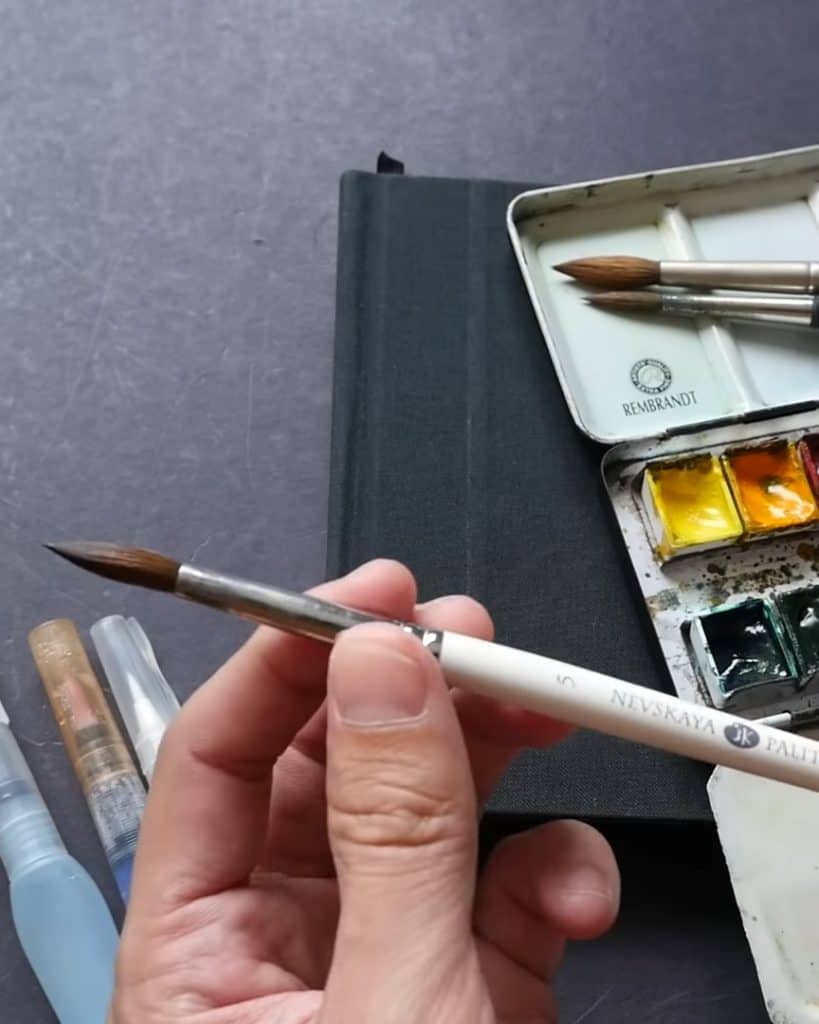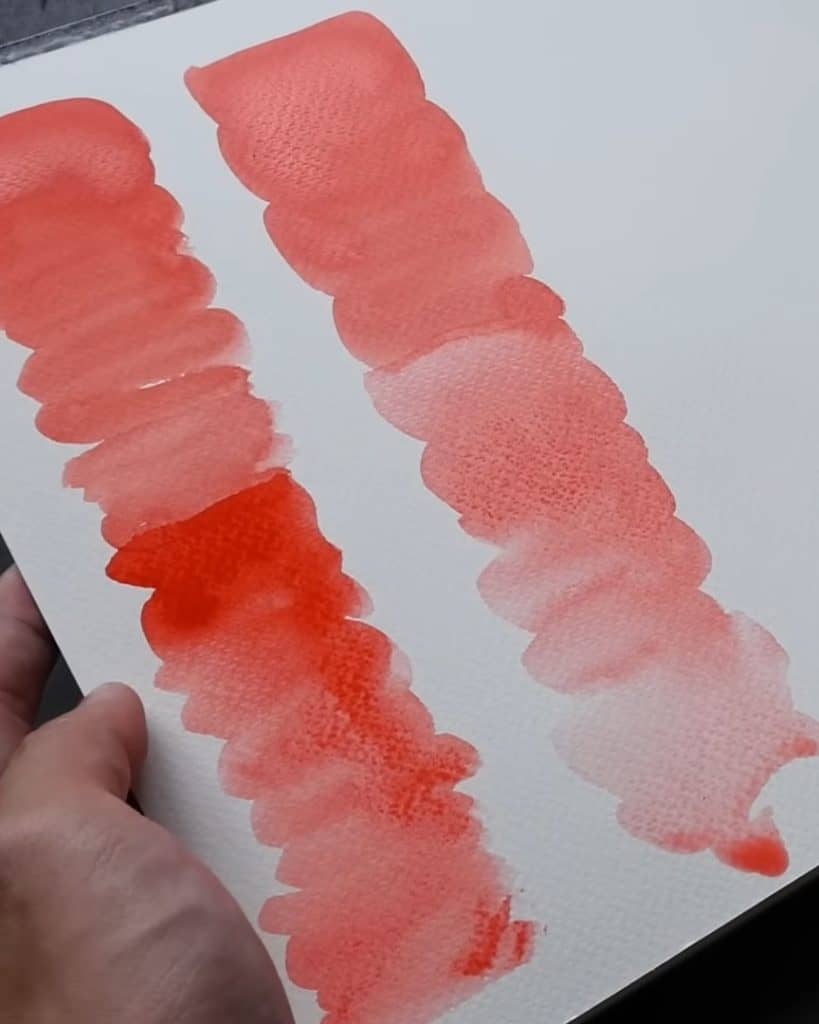Are you wondering whether a waterbrush or a normal brush is better for watercolor painting?
I’ve used both for years, and each has its own strengths and weaknesses.
When I first started sketching, I relied heavily on waterbrushes, but over time, I switched to normal brushes.
In this article, I’ll share my personal experience, comparing these two types of brushes and helping you decide which one suits your painting style best.
Contents
What is a Waterbrush?

Waterbrushes are a convenient option for watercolor artists, especially those who sketch on the go.
They have a built-in water reservoir, eliminating the need for a separate water container.
How a Waterbrush Works
A waterbrush has a hollow body that you fill with water.
When you press the body, water flows to the brush tip, allowing you to paint without dipping the brush into a separate water source.
This self-contained design makes it a popular choice for quick and portable painting sessions.
Benefits of Using a Waterbrush
Waterbrushes have several advantages that make them ideal for certain situations:
- Compact and portable: Perfect for travel and urban sketching.
- No need for a separate water source: The built-in reservoir means you don’t have to carry an extra bottle.
- Great for small details: Works well in small sketchbooks and tight areas.
- Quick and easy to use: Just squeeze the body, and water flows to the brush tip.
Limitations of a Waterbrush
Despite their convenience, waterbrushes have some drawbacks that can make painting more challenging:
- Difficult water control: Water flows continuously, making it hard to achieve even washes.
- Can cause patchy washes: Uneven water flow can create inconsistent results.
- Limited brush fiber options: Mostly synthetic fibers, lacking the softness of normal brushes.
What is a Normal (Natural) Brush?

Normal brushes or natural brushes are the traditional choice for watercolor painting.
Unlike waterbrushes, they do not have a built-in water supply, so you must dip them into water before applying paint.
How a Normal (Natural) Brush Works
A natural brush absorbs water and pigment, allowing for smooth and controlled application.
Since you control how much water the brush holds, you can easily create different effects.
This makes natural brushes a favorite among professional watercolor artists.
Benefits of Using a Normal Brush
Normal brushes provide many advantages that improve painting quality:
- Better water and pigment control: Allows for smoother washes and detailed brushwork.
- Higher-quality brush fibers: Options like sable and squirrel hair hold more water.
- Easier blending and layering: Helps achieve even color transitions.
- More brush shapes available: A wider variety of tip shapes for different techniques.
Limitations of a Normal Brush
Even though normal brushes offer excellent control, they also have a few downsides:
- Requires a water container: You need an extra bottle to rinse your brush.
- Less compact: Needs careful storage to avoid damaging the bristles.
- Can be expensive: High-quality normal brushes can cost more than waterbrushes.
Comparing Waterbrushes and Normal (Natural) Brushes in Practice
Both waterbrushes and normal (natural) brushes have their strengths, but they perform differently in real-world use.
Let’s compare how each type handles watercolor painting techniques.
How Waterbrushes Handle Watercolor

Waterbrushes continuously release water from the reservoir, making them easy to use but challenging to control.
You need to press the body to increase the water flow when painting. However, because of gravity, water can sometimes flow unpredictably, leading to uneven washes.
Another issue with waterbrushes is that they don’t hold as much pigment as natural brushes.
The synthetic bristles don’t absorb water well, so the brush dries out quickly as you paint.
To compensate, you have to squeeze more water from the reservoir, which can dilute the pigment and create an unintentional gradient effect.
How Normal (Natural) Brushes Handle Watercolor

Normal brushes give you full control over how much water you use.
Since you dip them into water manually, you decide how wet the brush is before applying paint.
This makes it much easier to create smooth, consistent washes.
Another key advantage is that normal brushes hold more pigment, thanks to their absorbent fibers.
This allows for richer colors and better blending.
When painting, you don’t have to keep adding water as frequently, which makes it easier to maintain even tones.
Creating a Flat Wash: Waterbrush vs. Normal (Natural) Brush

A flat wash is a fundamental watercolor technique where you apply an even layer of color across an area.
With a waterbrush, maintaining a consistent wash can be difficult. Because water constantly flows, the pigment gets diluted unevenly, leading to patchy results.
In contrast, a natural brush holds a good amount of water and pigment, allowing for smoother coverage.
You can adjust the moisture level by how much water you pick up with each dip. This makes it easier to achieve an even wash without unwanted streaks.
Creating a Graded Wash: Waterbrush vs. Normal Brush

A graded wash transitions from dark to light, requiring careful control over water and pigment.
With a normal brush, you can dip the brush in more water as you move downward, creating a seamless gradient.
A waterbrush, however, can be tricky for this technique. Since water continuously flows from the reservoir, it’s harder to control the dilution. You may end up with uneven transitions or unexpected patches of lighter color.
It takes practice to master this technique with a waterbrush.
Waterbrushes vs. Normal Brushes: How to Clean?
Proper cleaning is essential to maintain the performance of both types of brushes. The process differs depending on the brush type.
Cleaning a Waterbrush

Cleaning a waterbrush is simple. You just squeeze the brush to flush out old pigment and wipe it on a paper towel.
However, since water constantly flows, cleaning it thoroughly requires practice between color changes.
Cleaning a Normal Brush

For a normal brush, you need a water container to rinse it. This allows for faster color changes without cross-contamination.
Having a few brushes can make the process even easier if you’re working with multiple colors.
Choosing the Right Brush for Different Scenarios
Each brush type is suited for different painting situations. Knowing when to use each can improve your workflow.
Best Uses for Waterbrushes

I still use waterbrushes when:
- Small sketchbooks (A5 and below)
- Travel painting and outdoor sketching
- Quick, loose watercolor work
Best Uses for Normal Brushes

I always use normal (natural) brushes for:
- Larger paintings (A4 and above)
- Detailed watercolor work requiring precise control
- Smooth, even washes
My Current Brush Preference

These days, I mostly use natural brushes because they offer better control. However, carrying a water container can be inconvenient.
That’s why I started using pocket brushes—they’re a great alternative!
One of my favorites is the Da Vinci Maestro Pocket Brush. It has natural sable hair, giving me the same control as a regular brush, but in a compact design.
It’s collapsible, easy to store, and fits in my watercolor box. This way, I can enjoy the benefits of a natural brush while keeping my setup travel-friendly.
Final Thoughts
So, which one should you choose—a waterbrush or a normal brush?
It depends on your needs. If you paint on the go and want a simple setup, go for a waterbrush. A natural brush is the better choice if you prefer more control and smoother washes.
I personally use both, depending on the situation.
What about you? Let me know your thoughts in the comments!

